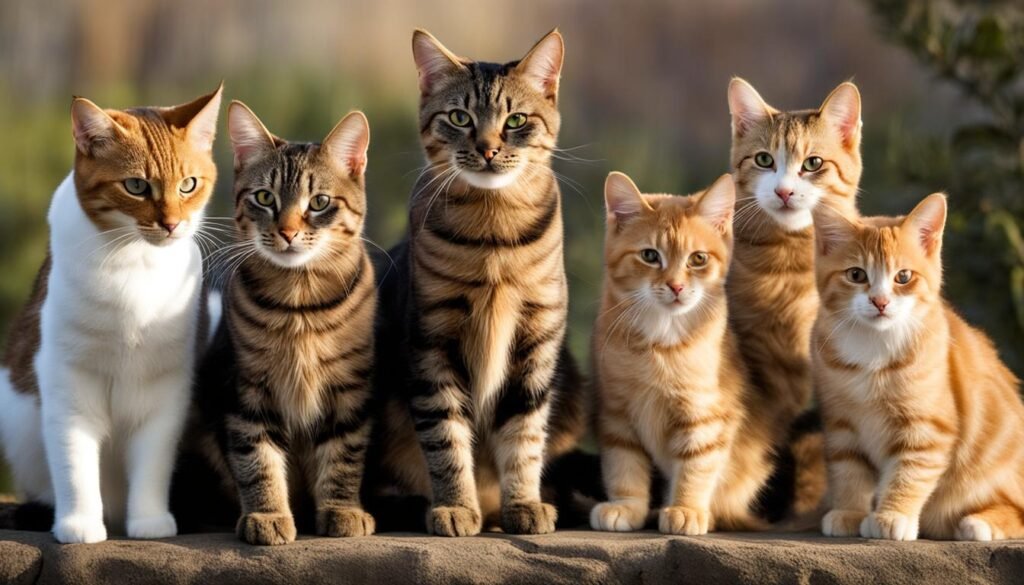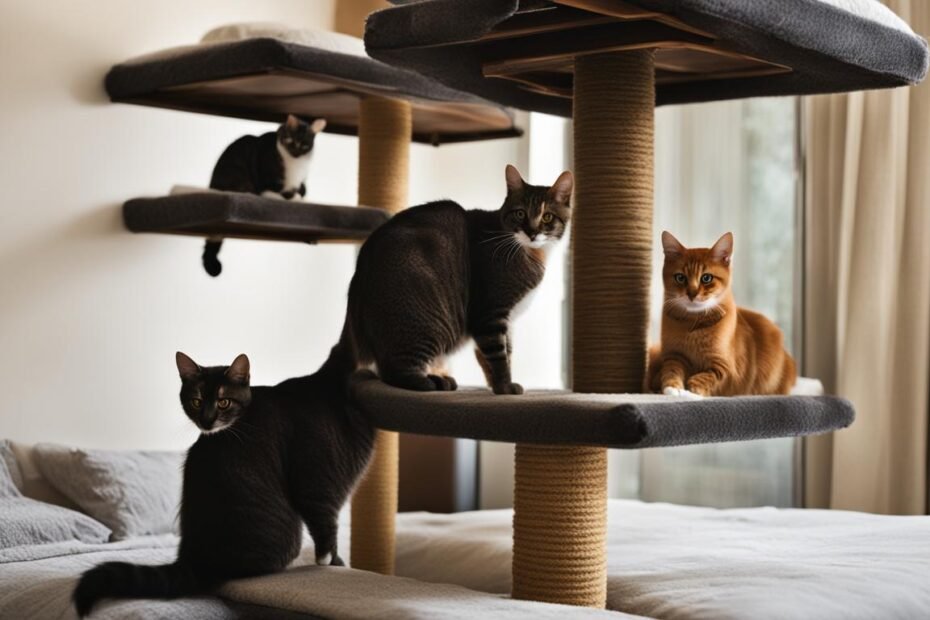Welcome to our guide on understanding and managing cat hierarchies in a multi-cat household. Cats are fascinating creatures with complex social structures that can sometimes lead to conflicts among housemates. By gaining insight into cat hierarchies and implementing effective strategies, you can promote harmony and ensure a peaceful cohabitation among your furry friends.
Key Takeaways:
- Understanding cat hierarchies is essential for fostering harmonious cohabitation among cats.
- Managing cat social structures involves observing behavior, providing sufficient resources, and rewarding positive interactions.
- Promoting equality among cats helps prevent conflicts and establish a peaceful multi-cat household.
- Introducing new cats or changes in maturity can disrupt the social structure, requiring careful observation and intervention.
- By implementing effective cat hierarchy strategies, you can create a comfortable environment where cats can live together happily.
Most Wild Cat Species are Solitary Predators
Wild cat species, except for lions, are typically solitary predators. They have their own territories and prefer to be alone for most of the time. Unlike their domestic counterparts, wild cats have not adapted to group living. Instead, they rely on their individual hunting skills and instincts to survive in their respective habitats.
The solitary nature of wild cats is ingrained in their social structure. They establish and defend their territories, marking them with scent and other markers to communicate their presence to other cats. This territorial behavior helps minimize competition for resources and reduces the chances of conflicts with other individuals.
While solitary living is the norm for most wild cat species, there are some exceptions. For instance, cheetahs are known to form small groups consisting of a mother and her offspring. This temporary association provides protection and support during the vulnerable stages of the cubs’ lives.
Table: Comparison of Social Structures in Wild Cat Species
| Species | Social Structure | Example |
|---|---|---|
| Lions | Pride (Group living) | A pride consists of multiple adult females, their offspring, and a coalition of adult males. |
| Tigers | Solitary | Tigers are solitary predators and establish and defend their territories. |
| Leopards | Solitary | Leopards are solitary animals that mark and defend their territories. |
| Cheetahs | Semi-Social | Cheetahs live in small family units consisting of a mother and her cubs. |
Understanding the social structure and behavior of wild cat species is essential for wildlife conservation efforts. It not only helps researchers gain insights into their ecology but also enables them to develop effective strategies for their protection and preservation in their natural habitats.
Feral Cat Colonies
Feral cat colonies are fascinating examples of how cats form social structures outside of human intervention. Contrary to previous beliefs, these colonies have a matriarchal structure, with female cats bonding together and sometimes raising their kittens as a joint litter. This cooperative behavior allows them to drive away threats, including male cats looking to mate.
The feeding order within feral cat colonies is determined by a combination of factors such as sex, body size, and age. Adult male cats tend to eat first, followed by females. Larger and older cats have priority over food, with kittens being given preference over adults. This hierarchy ensures that the colony’s members receive their fair share of resources and helps maintain order and stability.
Feral cat colonies also exhibit various social behaviors, such as grooming each other, playing, and engaging in vocal communication. These behaviors help strengthen social bonds and promote cooperation within the colony. Observing the dynamics of feral cat colonies provides insights into the innate social nature of cats and their ability to adapt to different social structures.
To better understand feral cat colonies, a summarized table is provided below:
| Aspect | Details |
|---|---|
| Structure | Matriarchal, with female cats bonding together |
| Feeding Order | Adult males eat first, followed by females |
| Social Behaviors | Grooming, playing, and vocal communication |
Understanding the social dynamics of feral cat colonies can provide valuable insights into managing cat hierarchies in multi-cat households. By observing their behavior and implementing strategies that promote fair resource allocation and positive interactions, cat owners can create a harmonious living environment for their feline companions.

Domestic Cat Social Structures & Colony Behavior
Domestic cats have a natural instinct to establish social structures within multi-cat households. Understanding their social dynamics and behaviors is essential for creating a harmonious environment for all feline housemates.
One of the key aspects of cat social structures is territorial marking. Cats use various methods, such as scent marking from facial glands and urine, to establish and communicate their territories. This territorial marking helps cats define boundaries and maintain a sense of security. Providing sufficient resources, such as food bowls, litter boxes, and resting areas, in different areas of the house can help prevent territorial disputes and promote a peaceful coexistence.
When introducing a new cat to the household, it’s important to understand the process of establishing hierarchy. Cats will engage in posturing, vocalizations, and various forms of communication to establish their rank within the social structure. This process may cause temporary conflicts and tension among cats as they adjust to the new dynamics. Patience, gradual introductions, and providing separate spaces for each cat during the initial stages can help facilitate a smoother integration.
“Cats are connoisseurs of comfort.” – James Herriot
To maintain a harmonious multi-cat household, it’s crucial to observe their behavior and intervene when necessary. Positive reinforcement for desired behaviors, such as sharing resources and peacefully interacting with each other, can help reinforce a positive social structure. Additionally, promptly addressing any signs of aggression or conflict, such as growling, hissing, or physical altercations, is vital to prevent the escalation of tensions.
Understanding domestic cat social structures and colony behavior allows cat owners to create an environment that promotes peaceful cohabitation. By providing adequate resources, recognizing territorial marking, and facilitating a smooth integration process when introducing new cats, cat owners can ensure a harmonious and enjoyable living environment for their furry friends.

| Behavior | Description |
|---|---|
| Territorial marking | Cats use scent marking and other communication methods to establish territories and boundaries. |
| Hierarchy establishment | Cats engage in posturing, vocalizations, and communication to establish their rank within the social structure. |
| Integration process | Gradual introductions and providing separate spaces for each cat can facilitate a smoother integration for new cats. |
| Positive reinforcement | Encouraging and rewarding desired behaviors, such as sharing resources and peaceful interactions, helps reinforce a positive social structure. |
| Conflict resolution | Promptly addressing signs of aggression or conflict is crucial to prevent tensions from escalating. |
Conclusion
Managing cat hierarchies is essential for creating a harmonious multi-cat household. By understanding the needs and behaviors of our feline friends, we can promote equality and ensure a peaceful cohabitation environment.
One key aspect of cat hierarchy management is providing enough resources for each cat. This includes separate feeding stations, litter boxes, and resting areas. By offering individual spaces, we prevent conflicts over territorial disputes and allow cats to establish their own domains.
Promoting positive interactions is another crucial factor. Encouraging playtime and providing interactive toys can help cats bond with each other and reduce aggression. Additionally, rewarding good behavior with treats and attention reinforces harmony among cats.
Addressing potential issues promptly is vital to maintaining a peaceful environment. If conflicts arise, it’s important to intervene, separate the cats if necessary, and gradually reintroduce them using controlled introductions. Seeking guidance from a veterinarian or animal behaviorist can also provide valuable insights and strategies for cat hierarchy management.
FAQ
Do domestic cats have a social structure?
Yes, domestic cats are capable of forming complex social structures within multi-cat households.
How do cats establish their social hierarchy?
Cats use subtle body language and pheromone markers to understand their position within the social structure and establish their own territories.
Can introducing a new cat disrupt the hierarchy?
Yes, introducing a new cat or reaching maturity can potentially disrupt the hierarchy and lead to conflicts among cats.
Do wild cat species live in groups?
No, wild cat species, except for lions, are typically solitary predators and prefer to be alone for most of the time.
How do feral cat colonies function?
Feral cat colonies have a matriarchal structure, with female cats bonding together and sometimes raising their kittens as a joint litter. They cooperate to drive away threats and establish feeding order based on factors such as sex, size, and age.
How do domestic cats mark their territories?
Domestic cats mark their territories with scent from facial glands, urine, and other markers to establish their own space within a multi-cat household.
What can I do to promote harmony among my cats?
By observing their behavior, providing sufficient resources, and rewarding positive interactions, you can promote a harmonious environment for your cats. It’s important to give each cat their own space and address any potential issues promptly.
How can I manage cat hierarchies at home?
Understanding and managing cat hierarchies involves providing enough resources for each cat, promoting positive interactions, and implementing strategies to prevent conflicts.
